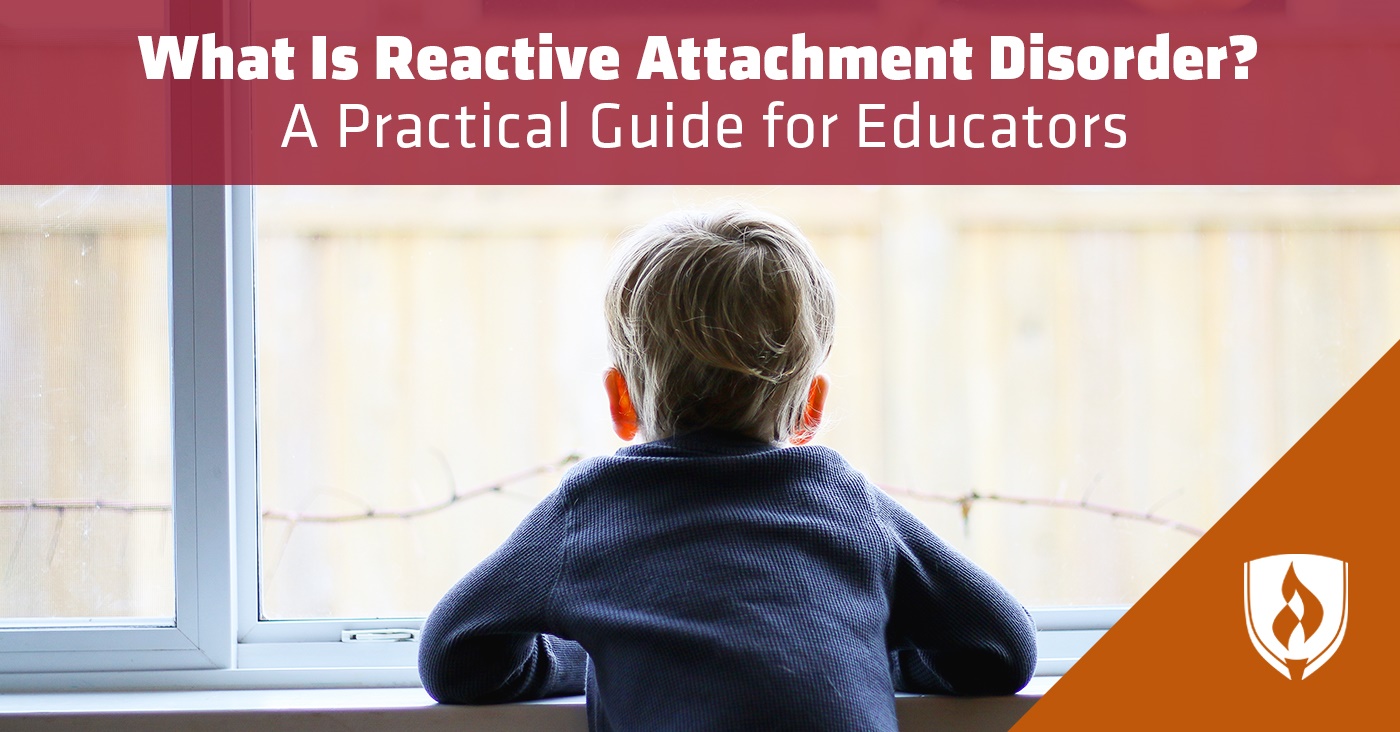What Is Reactive Attachment Disorder? A Practical Guide for Educators
By Anjali Stenquist on 06/01/2020

Working with young children can be a meaningful and joyful experience. It can also test your patience. But when does behavior cross the line from innocent tantrums into disordered patterns of volatility and distress?
Early childhood attachment influences the behavior of children as they grow and interact with other children and caregivers. If subject to neglect and an insecure attachment in their early months of life, children can develop serious behavioral challenges with long lasting implications.
If you find yourself consistently struggling to work with a child, you might want to consider if there are underlying issues influencing their behavior. Understanding the causes and symptomology of reactive attachment disorder (RAD) as well as milder forms of insecure attachment could be essential for providing the best possible care for your students.
We spoke with experts in the field of developmental psychology to understand how RAD manifests in children and compiled this practical guide for educators working with children with RAD or other forms of insecure attachment.
What is reactive attachment disorder?
Reactive attachment disorder is a disorder within the Diagnostic and Statistical Manual of Mental Disorders, Fifth Edition (DSM-5). It is described as a consistent pattern of inhibited, emotionally withdrawn behavior toward adult caregivers including seeking minimal comfort when distressed and having minimal response to an adult caregiver’s attempt to provide comfort.
RAD is a serious disorder that’s often misunderstood. What little information psychologists have about RAD largely comes from research on infants and toddlers raised in orphanages in Eastern Europe following the Cold War. As infants, these children received very minimal physical contact and comfort, dramatically inhibiting their ability to regulate their emotions and develop relationships later in life.
“What used to be called RAD is now broken up into two disorders with distinct characteristics: reactive attachment disorder (RAD) and disinhibited social engagement disorder (DSED),” explains Dr. Claire Thomas-Duckwitz, licensed psychologist and nationally-certified school psychologist.
Dr. Thomas-Duckwitz explains that reactive attachment disorder is often used colloquially to describe insecure attachment, but the disorder is actually quite rare. The DSM-5 estimates that 10 percent of foster children are effected by RAD, and 20 percent of foster children fall into the category of DSED.
“Although they both reflect missed opportunities for early attunement and attachment, one manifests in a more internalizing manner (RAD) and the other (DSED) as more externalizing,” she explains.
As an educator, it’s possible you’ll work with children who suffer from the extreme emotional upheaval of RAD or DSED. However, it’s more likely you’ll work with children who have a milder, subclinical level of insecure attachment.
These children will exhibit many of the same symptomologies as children with RAD or DSED, but at levels less extreme than would qualify as a diagnosable case of either disorder. Insecure attachment, the cause of RAD and DSED, can cause emotional instability in children leading to a challenging educational environment.
What causes insecure attachment?
Infants are dependent on a parental figure both physically and emotionally. The relationship between a baby and its caregiver informs how a child understands the world around them. Physical contact and comforting by that primary caregiver teaches infants how to soothe themselves and recover from distress. If that primary caregiver does not give sufficient physical or emotional care, the child develops what psychologists call an “insecure attachment.”
In the 1970s, psychologist Mary Ainsworth developed an experiment called the Strange Situation. In this experiment a child is observed playing for a period of 21 minutes. During this time the child’s caregiver and then a stranger enter and leave the room. The child is observed responding to the presence of the familiar caregiver and the stranger.
Ainsworth found that children fell into four categories depending on their relationship with the caregiver. If the child has a secure attachment with the caregiver, they feel comfortable in the caregiver’s presence even if the stranger is also in the room. The caregiver has provided consistent safety and support and the child feels secure enough to explore new situations and new people. The distress the child feels being separated from the caregiver at the start of the experiment is effectively managed when the caregiver comes back into the room and comforts the child.
If the child has not experienced consistent safety and support with the caretaker, they demonstrate insecure attachment in one of three ways:
- Anxious-avoidant attachment: The child ignores or avoids the caregiver and does not show distress when the caregiver leaves the child alone at the start of the experiment.
- Anxious-ambivalent/resistant attachment: The child shows distress even before the separation and is difficult to comfort even when the caregiver returns.
- Disorganized/disoriented attachment: The child demonstrates persistent stress and fear.
The commonality in all three of these patterns of insecure attachment is that the child does not believe the caregiver will provide for their needs.
“Think of insecure attachment as a superficial and inappropriate manner of engaging the world in order to feel one's needs are met,” Dr. Thomas-Duckwitz explains. She describes the following symptoms of insecure attachment:
- Disinhibition with approaching and/or going off with unfamiliar adults
- Lack of checking back with an adult caregiver after venturing off (essentially indicating the primary attachment figure is not considered a "secure base.")
- Overly familiar verbal or physical behavior with unfamiliar people (e.g., running up to an adult upon first meeting them and giving them a hug, sitting on their lap, or saying "I love you!")
These all have to be due to an early environment in which there was deprivation in basic social /emotional/physical needs, frequent change in primary caregivers, or no opportunity to form selective attachments (i.e., orphanages). The deprivation must have also occurred somewhere between the ages of 9 months and 2 years.
“The timeframe of nine months to two years is important because that's when kids are really learning self-regulation, emotional responses and how reliable the world is through a process called attunement,” Dr. Thomas-Duckwitz explains. “This is a critical period for attunement, so if that opportunity is missed, the brain reflects a world in which emotions feel chaotic, there is little social reciprocity, caregivers cannot be relied upon, and in which there is little verbal order.”
What are signs children might be struggling with insecure attachment?
Reactive attachment disorder is primarily identified in children who are consistently inhibited and withdrawn toward adult caregivers. In these instances, the neglect the child experienced as an infant was so extreme that they cannot accept, understand or receive help from an adult caregiver when they are distraught. They have also never learned how to comfort themselves, leaving them in painfully heightened emotional distress without relief.
Insecure attachment can also present in the opposite behavioral patterns to withdrawal. Sometimes children will behave in an overly familiar way with adult caregivers despite having no meaningful bond developed with those adults. Though they seek out closeness with adult caregivers, they cannot process the emotional support those caregivers are attempting to provide.
Both manifestations of insecure attachment can create major challenges for caregivers and educators alike. The most critical work to do as an educator is ensure the child is receiving support from all necessary parties in their life as they learn to self-regulate and relearn what to expect from their surroundings.
How to support children dealing with insecure attachment
As you work with children with insecure attachment, keep in mind three simple tactics.
1. Cultivate your own stress management skills
Working with children with insecure attachment is challenging and emotionally draining. Developing strong tools to navigate your own emotions and stress not only protects your mental and emotional health, but also supports the child in overt and subtle ways.
“Teachers and staff need to be aware of their own dysregulation and have their own calming strategies, or their dysregulation may be triggering for kids,” Dr. Thomas-Duckwitz advises. “Being a reliable person who responds to the emotional needs of all students is important—even when they feel the child is sabotaging the relationship.”
Maintaining a consistent routine and having classroom rituals with meaning is important. Having and modeling clear boundaries in a calm, consistent manner is also significant.
2. Stay mindful of the child’s internal world
Children dealing with insecure attachment have a deeply chaotic internal world. Their disruptive or challenging behavior is a result of a kind of isolation and pain that is difficult to fully comprehend.
“The most surprising thing I have found about children with reactive attachment disorder is often how broken they are inside in regards to the high levels of emotions that are swirling inside of them. Emotions of confusion, pain, loss, anger and so much more,” explains Dr. John DeGarmo, founder and director of the Foster Care Institute. “These children are filled with anxiety, and often do not know how to fully comprehend or cope with these feelings and emotions.”
3. Celebrate success, no matter how small
Practically, what is the most significant method of working with children with insecure attachment such as RAD? Sharing moments of joy and celebration.
“Celebrate any success they might have with their behavior, however small that success might be,” Dr. DeGarmo advises. “Try to find moments where the two of you can laugh with each other, and try to cultivate a feeling of joy. Most likely, they have come from a home where there was little laughter and little joy.”
Support little learners in your care
As an early childhood professional who is passionately devoted to the young ones you work with, it can be difficult to witness a child dealing with reactive attachment disorder or similar conditions. Consider the advice from Dr. Thomas-Duckwitz and Dr. DeGarmo to help navigate these scenarios.
If you are concerned about a child’s behavioral development, early intervention programs are a possible resource. Learn more about it in our article, “What Is Early Childhood Intervention? What ECE Professionals Should Know”.




